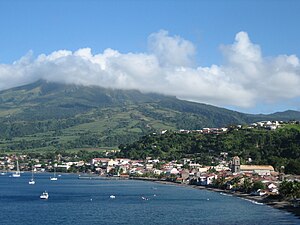Saint-Pierre (Martinique)
| Saint-Pierre | |
|---|---|

|

|
| region | Martinique |
| Department | Martinique |
| Arrondissement | Saint-Pierre ( sub-prefecture ) |
| Community association | Pays North Martinique |
| Coordinates | 14 ° 45 ′ N , 61 ° 11 ′ W |
| height | 0-1,395 m |
| surface | 38.72 km 2 |
| Residents | 4,123 (January 1, 2017) |
| Population density | 106 inhabitants / km 2 |
| Post Code | 97250 |
| INSEE code | 97225 |
| Website | www.saint-pierre-mq.fr |
 Saint-Pierre |
|
Saint-Pierre [ ˌsɛ̃ˈpjɛʀ ] is a coastal city with 4123 inhabitants (as of January 1, 2017) in the northwest of the French Caribbean island of Martinique . It is located 31 kilometers north of the island's capital Fort-de-France . The formerly prosperous and prosperous settlement was the capital for several centuries and also the nucleus of colonization of the whole island. It was destroyed in 1902 by an eruption of the Montagne Pelée volcano , which rises seven kilometers to the northeast , and has developed into a popular tourist destination after its reconstruction.
history
In 1635, Saint-Pierre was founded by Pierre Belain d'Esnambuc (1585–1636), the first governor of the Caribbean island of Saint-Christophe , on behalf of Cardinal Richelieu . Until the relocation of the governor's seat to Fort-de-France in 1692, it was the administrative and trading capital of Martinique until 1902. The last indigenous people, the Caribs , took their own life by falling from a high sea rock (now known as the Tombeau des Caraïbes - Carib Tomb ) north of the city in order not to fall under the yoke of colonization or slavery.
The sugar and slave trade allowed the city to flourish and prosper, so that it developed into the economic and cultural center of the entire Lesser Antilles and was given nicknames such as Little Paris, Paris of the Islands, Pearl of the Antilles or Venice of the tropics . Merchant ships from all over the world called at the port and Saint-Pierre had modern technology facilities and important buildings earlier than many other cities, including larger cities. In addition to a chamber of commerce , a horse-drawn tram , an impressive theater for 800 spectators , an electric street lighting network and a botanical garden , Saint-Pierre owned the Asile Bethléem, one of the first nursing homes for the mentally ill .
On the morning of May 8, 1902, an eruption of Mount Pelée completely destroyed the city within a few minutes. Of the 28,000 inhabitants at the time, only three survived the glowing cloud . The ruins burned to the ground for several days. Due to the enormous heat development, it was initially not possible to approach Saint-Pierre.
Today's city
The city lay in ruins for several decades before reconstruction began. Nowadays the city has only a sixth of the population that it had before the volcanic eruption, but is now an extremely popular tourist destination and lives almost exclusively from this industry. It is classified as a “City of Art and History” ( French: “Ville d'art et d'histoire”). The mountain can be climbed and hobby divers have the opportunity to go on excursions to the ships that sank in the port or just off the coast, which sank when the glowing cloud reached the sea.
The faithfully reconstructed building of the Chamber of Commerce is one of the most beautiful architectural examples on the island. Other sights are the Église-de-la-Nativité (Church of the Nativity) and the former Notre-Dame-de-l'Assomption Cathedral ( Monument historique ) in the Quartier du Mouillage and the Musée Franck A. Perret (after Frank A. Perret ), which informs about the volcanological history and exhibits finds of the destroyed city. The ruins of the theater , the fort church and the nursing home can also be visited.
sons and daughters of the town
- Pierre César Dery (1768–1812), general of the cavalry
- Paul Fabre-Domergue (1861–1940), physician, naturalist and embryologist
- Guy Modeste (1954-2018), football player
literature
- Antoine Lacroix : La Montagne Pelée et ses éruptions . Masson & Cie, Paris 1904.
- Moritz Alphons Stübel : Review of the eruption period of Mont Pelé on Martinique from 1902 to 1903 from a theoretical point of view . Weg-Verlag, Leipzig 1904.
- Alwyn Scarth: La Catastrophe. The Eruption of Mount Pelée . Oxford University Press , Oxford 2002. ISBN 978-0-19-521839-8 .
- Ernest Zebrowski jr .: The Last Days of St. Pierre: the volcanic disaster that claimed thirty thousand lives . Rutgers University Press , New Jersey 2002, ISBN 0-8135-3041-5 ( ISBN 978-0-8135-3041-3 )
